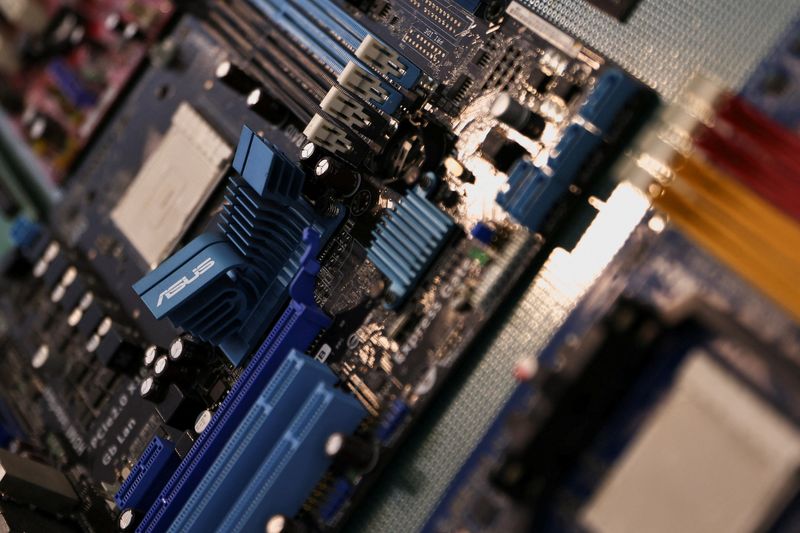By Josh Horwitz
SHANGHAI (Reuters) - China's semiconductor industry has become a key target of the United States, which has imposed a slew of export restrictions targeting several parts of the country's chip sector supply chain as it bids to slow its rival's technological advancement.
While Beijing has ploughed vast sums of money into cultivating a domestic chip industry, its fabrication plants, known as fabs, still heavily rely on foreign-made equipment that they use to turn slabs of silicon into chips that power hardware.
Below are the Chinese fabs that are bearing the biggest brunt of Washington's curbs:
SEMICONDUCTOR MANUFACTURING INTERNATIONAL CORP (SMIC)
SMIC, China's largest fab, makes chips that go into a range of products for the automotive sector, internet-of-things devices and some smartphones.
Founded in 2000 with backing from the Shanghai government, the firm stands as China's would-be rival to Taiwan Semiconductor Manufacturing Co Ltd (TSMC), though it is dwarfed in technology and income. TSMC is the world's most valuable chipmaker and counts Apple Inc (NASDAQ:AAPL) and Nvidia (NASDAQ:NVDA) Corp among major clients.
Its government-backing and ambition to make high-end chips caught the attention of the United States which put the firm on its Entity List in 2020. The placement effectively barred Dutch firm ASML Holding (NASDAQ:ASML) AS from providing critical Extreme Ultraviolet lithography machines to SMIC, scuttling that ambition.
To date, most of SMIC's sales are made using the outdated 45 nanometer process node and above. Since late 2020, this specialisation in older chips has proven a boon due to a global shortage of lower-end chips.
Still, its global market share in the pure-play foundry sector remains in the single digits, and its sales and research-and-development expenditure remain well below those of TSMC.
The company shocked the industry in 2022 when researchers discovered it had produced a chip that appeared to share qualities with TSMC's 7 nanometer process node technology, even without ASML equipment.
Experts disputed the long-term viability of its breakthrough. SMIC has not responded to the findings.
HUA HONG SEMICONDUCTOR LTD
Hua Hong Semiconductor Ltd is China's second-largest fab. It was founded in 1996 and specialises in making mature-node technology, generating most of its revenue from chips made at the 55 nanometer process node and above.
The firm has devoted fewer resources to producing advanced nodes than SMIC. It plans to conduct an additional public offering in 2023, and aims to build a new fab in the eastern city of Wuxi.
YANGTZE MEMORY TECHNOLOGIES CO LTD (YMTC)
YMTC is China's only player in the global NAND memory market - an ultra-competitive sector long dominated by a handful of firms from the United States and Korea. It designs and makes chips and was added to the U.S. Entity List last year.
While YMTC's market share of the overall sector is small, experts said it has steadily entered the Chinese supply chain and that its products have become more competitive on price and quality.
It unveiled a chip last year with 232 layers of memory cells, placing the firm closer to rivals such as South Korea's Samsung Electronics (OTC:SSNLF) Co Ltd. Experts said equipment export restrictions are likely to derail further efforts.
YMTC was founded in 2016 with backing from the Wuhan government and China National Integrated Circuit Industry Investment Fund, and originally operated under chip conglomerate Tsinghua Unigroup. It was later spun out as its parent company restructured while facing bankruptcy.
CHANGXIN MEMORY TECHNOLOGIES (CXMT)
CXMT is China's only major player designing and making DRAM chips, which like NAND memory, is a sector long dominated by a handful of legacy companies in the United States, South Korea and Taiwan.
It has one fab in operation and is building two others. It produces DRAM at the 19 nanometer node and is moving into the 17 nanometer node - process nodes behind the industry leading-edge.
Researcher Trendforce wrote that the impact from equipment export restrictions imposed since October might affect expansion plans.
